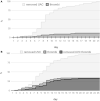Ultrasound Monitoring of Umbilical Catheters in the Neonatal Intensive Care Unit-A Prospective Observational Study
- PMID: 33996700
- PMCID: PMC8119780
- DOI: 10.3389/fped.2021.665214
Ultrasound Monitoring of Umbilical Catheters in the Neonatal Intensive Care Unit-A Prospective Observational Study
Abstract
Introduction: Umbilical catheterization provides a quick yet demanding central line that can lead to complications seen nowhere else. The aim of our study was to determine whether the repeated ultrasound scanning can influence the catheterization time, prevent some of the catheter-related complications, support the decision-making process and allow prolonged catheterization in patients without an alternative central access route. Methods: A prospective observational study was performed in a tertiary neonatal intensive care unit. A total of 129 patients and 194 umbilical catheters (119 venous and 75 arterial) were analyzed with a total of 954 scans. Ultrasound screening consisted of 1) assessing the catheter tip, location, movability, and surface and 2) analyzing the catheter trajectory. The outcome variables were defined as 1) catheter dislocation and 2) associated thrombosis. Results: Dislocation of catheter throughout the whole catheterization period was observed in 68% (81/119) of UVCs and 23% (17/75) of UACs. Thrombotic complications were observed in 34.5% (41/119) of UVCs and 12% (9/75) of UACs. 1/3 of UAC-associated thrombi were visible only after catheter removal. 51% (61/119) of UVC patients and 8% (6/75) of UAC patients made a clinical decision regarding the obtained catheter image. Conclusion: Bedside ultrasound imaging of catheters supports the decision-making process related to the catheterization duration, shortening the time if abnormalities are detected and allowing a safer prolonged UC stay when an alternative central line cannot be inserted.
Keywords: bedside monitoring; catheter-related thrombosis; neonatal intensive care unit; prematurity; umbilical catheters.
Copyright © 2021 Sobczak, Dudzik, Kruczek and Kwinta.
Conflict of interest statement
The authors declare that the research was conducted in the absence of any commercial or financial relationships that could be construed as a potential conflict of interest.
Figures




Similar articles
-
Adverse events associated with umbilical vascular catheters in the neonatal intensive care unit: A retrospective cohort study.Aust Crit Care. 2024 Sep;37(5):747-754. doi: 10.1016/j.aucc.2024.01.013. Epub 2024 Mar 13. Aust Crit Care. 2024. PMID: 38485556
-
A review of umbilical venous catheter-related complications at a tertiary neonatal unit in Singapore.Singapore Med J. 2021 Jan;62(1):29-33. doi: 10.11622/smedj.2019140. Epub 2019 Nov 4. Singapore Med J. 2021. PMID: 33619572 Free PMC article. Review.
-
Sonography for Complete Evaluation of Neonatal Intensive Care Unit Central Support Devices: A Pilot Study.J Ultrasound Med. 2016 Jul;35(7):1465-73. doi: 10.7863/ultra.15.06104. Epub 2016 May 26. J Ultrasound Med. 2016. PMID: 27229130
-
Role of ultrasound for central catheter tip localization in neonates: a review of the current evidence.J Matern Fetal Neonatal Med. 2019 Jul;32(14):2429-2437. doi: 10.1080/14767058.2018.1437135. Epub 2018 Feb 15. J Matern Fetal Neonatal Med. 2019. PMID: 29397784
-
Umbilical Venous Catheter Update: A Narrative Review Including Ultrasound and Training.Front Pediatr. 2022 Jan 31;9:774705. doi: 10.3389/fped.2021.774705. eCollection 2021. Front Pediatr. 2022. PMID: 35174113 Free PMC article. Review.
Cited by
-
Indications, Measurements, and Complications of Ten Essential Neonatal Procedures.Int J Pediatr. 2023 Sep 5;2023:3241607. doi: 10.1155/2023/3241607. eCollection 2023. Int J Pediatr. 2023. PMID: 37705709 Free PMC article. Review.
-
Real-time ultrasound to assess the umbilical catheter position in neonates: a randomized, controlled trial.J Perinatol. 2025 Feb;45(2):235-241. doi: 10.1038/s41372-024-02128-6. Epub 2024 Oct 9. J Perinatol. 2025. PMID: 39379732 Free PMC article. Clinical Trial.
-
Novel ultralow positioning of the umbilical artery catheter: A prospective pilot study.J Ultrason. 2024 Nov 30;24(98):1-6. doi: 10.15557/jou.2024.0024. eCollection 2024 Dec. J Ultrason. 2024. PMID: 39619265 Free PMC article.
-
Outcomes of Femoral Arterial Catheterisation in Neonates: A Retrospective Cohort Study.Children (Basel). 2022 Aug 20;9(8):1259. doi: 10.3390/children9081259. Children (Basel). 2022. PMID: 36010148 Free PMC article.
References
-
- Singh Y, Tissot C, Fraga MV, Yousef N, Cortes RG, Lopez J, et al. . International evidence-based guidelines on Point of Care Ultrasound (POCUS) for critically ill neonates and children issued by the POCUS Working Group of the European Society of Paediatric and Neonatal Intensive Care (ESPNIC). Crit Care. (2020) 24:1–16. 10.1186/s13054-020-2787-9 - DOI - PMC - PubMed
-
- WHO . Preterm Birth. Fact Sheet; (2014).
-
- Oski F, Allen D, Diamond L. Portal hypertension a complication of umbilical vein catheterization. Pediatrics. (1963) 31:297–302. - PubMed
LinkOut - more resources
Full Text Sources
Other Literature Sources

